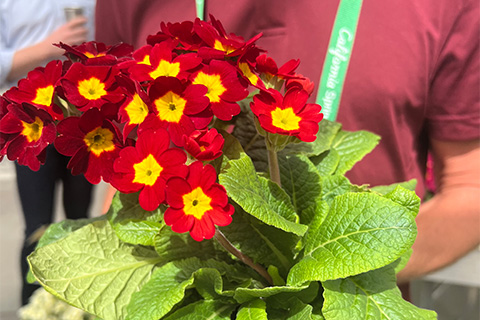9/30/2025
More For Your Store
Chris Beytes, Bill Calkins & Jennifer Zurko

New Cyclamen From Morel
The newest cyclamen series from Morel is named Macaron and it’s the smallest of their “mini” type—bred for 2.5- to 4-in. pots. Andre from Morel said Macaron is the most genetically compact series on the market and it has high heat tolerance for summer production. Macaron launches with seven colors and two mixes.
Also new from Morel are two for the miniature-sized Metis series— Coral Edge and Lilac. (Right)
Coral Edge and Lilac. (Right)
 The cyclamen breeders get into some pretty esoteric distinctions among their varieties. Such as the naming of a particular flower pattern like “Victoria,” which is a little band of color called a “crown.” Dreamscape Victoria Salmon is the first “Victoria” type within the midi Dreamscape series.
The cyclamen breeders get into some pretty esoteric distinctions among their varieties. Such as the naming of a particular flower pattern like “Victoria,” which is a little band of color called a “crown.” Dreamscape Victoria Salmon is the first “Victoria” type within the midi Dreamscape series.
 Streptocarpus Ladyslippers (Green Fuse)
Streptocarpus Ladyslippers (Green Fuse)
Their Ladyslippers collection gets its first double-flowered varieties: Double Midnight and Double Blue Ice.
 Grevillea Eternal Pink Glory (Plant Development Services, Inc.)
Grevillea Eternal Pink Glory (Plant Development Services, Inc.)
It’s fun when we see a variety so new it didn’t have a name when we saw it, which is the case with a pretty Australian native called grevillea, AKA spider flower. It resembles a spreading pine with funky red spider-like flowers. And while an Aussie native, this one was bred in California.
 Nandina Red Light (Plant Development Services, Inc.)
Nandina Red Light (Plant Development Services, Inc.)
Nandina Red Light starts reddish pink and matures to pinkish white. Plants are compact, but full, and it’s hardy from Zones 6 to 10.
 Dianthus Sprint (Dümmen Orange)
Dianthus Sprint (Dümmen Orange)
For early in the season, a couple of new dianthus—a new series and a series that’s been available in Europe and has made its way across the pond. Dianthus Sprint comes to us after three years in Europe. It’s compact, but programmable, to hit all the major gift-giving spring holidays. Sprint comes in nine colors. The domestic production of cuttings is in Encinitas, California. More vigorous than Sprint is Arabella, an all-new series with traditional carnation blooms in three colors.

Primrose Lighthouse Scarlet (Sakata)
Sakata adds Scarlet to the Lighthouse series, bringing the color count up to six and a mix. The Lighthouse series is known for being compact (without PGRs) and having multiple flowers on each stem that keep blooming continuously through the season. Looking at the plants, you’ll notice longer flower stems, which actually reduces Botrytis risk.
 Calla Captain (ThinkPlants)
Calla Captain (ThinkPlants)
The folks at Kapiteyn, home of Captain Callas, had a nice collection of Dutch-bred and propagated calla lilies. They tout the fact that, because the Dutch are so well-versed at storing flower bulbs of all types, they can offer callas for any holiday ... in fact, they were promoting the rich rose pink variety Captain Cheerio for next Valentine’s Day.
 Alstroemeria Colorita (ThinkPlants)
Alstroemeria Colorita (ThinkPlants)
Royal Van Zanten showed off some new members of the Alstroemeria Colorita series, both with variegated foliage. Lynne has cream-colored blooms with pink blush foliage and Lizzie is cherry red. As a reminder, Coloritas are dwarf alstroemeria that don’t require PGRs or pinching.
 Hellebore Frostkiss Cherisa (Pacific Plug & Liner)
Hellebore Frostkiss Cherisa (Pacific Plug & Liner)
PP&L is big on hellebores and this year they showed Cherisa, part of the Frostkiss collection. Cherisa is bred to be later blooming than other hellebores for key retail timing. Cherisa’s flowers open yellow to green and mature to burgundy, with excellent branching and a vigorous habit.
 Hellebore Ice ‘n Roses (ThinkPlants)
Hellebore Ice ‘n Roses (ThinkPlants)
Heuger joined ThinkPlants two years ago, bringing 75 years’ experience in high-quality plant production to the table focused on hellebores. New in the 2026 range is a collection called Ice ‘n Roses, precision bred to have outward-facing flowers. Add in heat tolerance for growers in southern climates and you’ve got a win-win.
 Verticodia Rey (Nir)
Verticodia Rey (Nir)
Nir is a regular exhibitor at CAST and they breed the Australian native chamelaucium (wax flower) for both cuts and pots—we’ve shown you those before. Their newest offering is 20 years in the making: a cross between chamelaucium and another Aussie called verticordia to create Rey. They’ve had the cut-flower version of it for a while; now they’re growing it as a potted plant. The little orange flowers are said to last three months! It’s new and they’re looking for partners in North America to produce it.
 Kalanchoe pumila Silver (Jaldety)
Kalanchoe pumila Silver (Jaldety)
Named for its unique, low-growing foliage, Silver does flower, but the foliage color is the key selling point. GP